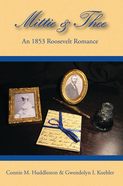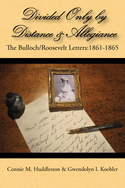The museum shop at Bulloch Hall offers a unique collection of historical mementos and charming gifts. We hope you will enjoy browsing through our books about the Home, the Bulloch and Roosevelt families, President Theodore Roosevelt, cookbooks, and history.
Literature Available in the Shop

Mittie and Thee, An 1853 Romance (Book I)
North met South—an enduring love affair began—the birth of a President resulted. This 1853 story, told through one year of courtship letters between New York City’s Theodore Roosevelt (Senior) and Miss Mittie Bulloch of Georgia, echoes through time. Her heritage is one of patriotism, education, and Southern social standing. He is the fifth son of a wealthy New York City businessman of Dutch heritage. Their 1853 courtship conducted though letters gives the reader an intimate peek into their personal love story.
Connie Huddleston and Gwendolyn Koehler have compiled the love letters of Mitte Bulloch and Theodore Roosevelt - Transcribed and presented just as written. The authors of the book allow the letters to stand on their own, with only necessary background regarding people, places, and the social mores of 1853 mentioned in the letters. This fascinating book allows an interesting peek into the courtship of the two young lovers. This is the ultimate love story to be shared.
North met South—an enduring love affair began—the birth of a President resulted. This 1853 story, told through one year of courtship letters between New York City’s Theodore Roosevelt (Senior) and Miss Mittie Bulloch of Georgia, echoes through time. Her heritage is one of patriotism, education, and Southern social standing. He is the fifth son of a wealthy New York City businessman of Dutch heritage. Their 1853 courtship conducted though letters gives the reader an intimate peek into their personal love story.
Connie Huddleston and Gwendolyn Koehler have compiled the love letters of Mitte Bulloch and Theodore Roosevelt - Transcribed and presented just as written. The authors of the book allow the letters to stand on their own, with only necessary background regarding people, places, and the social mores of 1853 mentioned in the letters. This fascinating book allows an interesting peek into the courtship of the two young lovers. This is the ultimate love story to be shared.

Between the Wedding and the War (Book II)
The sequel to Mittie & Thee, An 1853 Romance was released on October 5th. Between the Wedding and the War continues the story of two families, the New York Roosevelts and our own Roswell Bullochs with letters from 1854-1860. Written by Gwendolyn Koehler and Connie Huddleston, the book features letters transcribed and presented just as they were written. The book is available in the Bulloch Hall Museum Shop and on Amazon.
The sequel to Mittie & Thee, An 1853 Romance was released on October 5th. Between the Wedding and the War continues the story of two families, the New York Roosevelts and our own Roswell Bullochs with letters from 1854-1860. Written by Gwendolyn Koehler and Connie Huddleston, the book features letters transcribed and presented just as they were written. The book is available in the Bulloch Hall Museum Shop and on Amazon.

Divided Only by Distance & Allegiance: The Bulloch/Roosevelt Letters 1861-1864 (Book III)
The year 1861 found the Bulloch and Roosevelt families divided by allegiance. Now living in the North, the Bulloch women supported their Southern roots, while their northern husbands stayed true to the Union. The War created additional hardships, limiting the family’s correspondence, travel, and finances. With two sons fighting for the South and one dying back home in Georgia, the family letters tell of the ladies’ struggles to aid and comfort those they loved, all amidst a background of the Civil War.
The year 1861 found the Bulloch and Roosevelt families divided by allegiance. Now living in the North, the Bulloch women supported their Southern roots, while their northern husbands stayed true to the Union. The War created additional hardships, limiting the family’s correspondence, travel, and finances. With two sons fighting for the South and one dying back home in Georgia, the family letters tell of the ladies’ struggles to aid and comfort those they loved, all amidst a background of the Civil War.